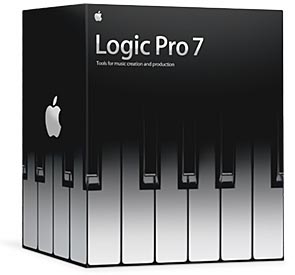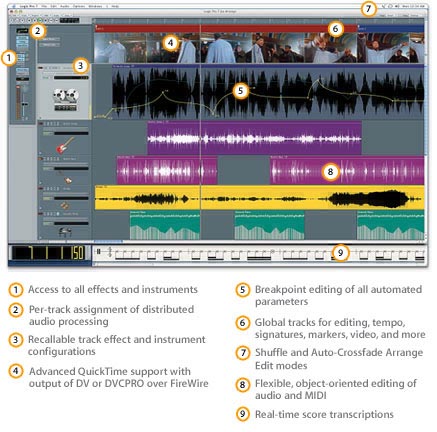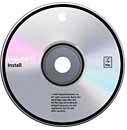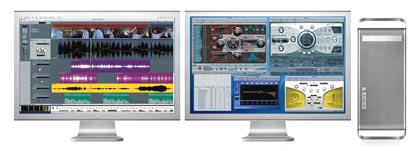
Eur 1.069,00 full version
$299.00 upgrade
Logic is now available from Apple Computer.
You can find Logic Pro 7 at an Apple Store or an Apple authorized reseller.
Emagic continues to support its customers.
The new distributed audio processing feature in Logic Pro 7 offers a plug-and-play solution that provides the ability to tap networked computers for more DSP processing power. Simply add one or more Macintosh systems via Ethernet or FireWire to your Logic Pro 7 system. The result is an audio and music production system with processing up to 128 stereo streams.
It supports audio at 16- and 24-bit resolution and sample rates of up to 192kHz for both audio recording and playback of internal software instruments.
System Requirements
* Macintosh computer with PowerPC G4 or faster processor (G5 or dual G4 processors recommended)
* PowerPC G5 and Gigabit Ethernet connectivity for Logic Node applications
* Mac OS X v10.3 or later
* 512 MB of RAM
* DVD drive for software installation
* Available USB port for XSKey (copy protection)
* Low-latency multi-I/O audio hardware and MIDI interface recommended
* 4GB of available hard drive space
*Additional system requirements may apply when using Digidesign's TDM systems.

Logic Pro 7 Specifications
Audio production
• Network-distributed audio processing to expand power for software instruments and effects
• Track Freeze to extend processing capability for a single computer
• High-end POW-r dithering algorithm
• Audio resolution up to 24-bit/192kHz
• Shuffle and Auto-Crossfade Arrange Edit modes
Instruments and effects
• 34 software instruments, including Sculpture; Ultrabeat; EVP88, EVB3, and EVD6 vintage instruments; and ES1, ES2, EFM1, ESM, ESP, and ESE synthesizers
• EXS24 mk II sampler with comprehensive sampler instrument library
• Over 70 effect plug-ins, including Guitar Amp Pro, Ringshifter, Linear Phase EQ, Match EQ, Vocal Transformer, EVOC20 Vocoder, Space Designer convolution reverb, and Pitch Correction
Professional mixing and automation
• Adaptive Track Mixer for display of selected channels
• Save/Load Channel Strip instrument and plug-in configurations
• Sample-accurate, track-based 32-bit automation
• Extensive Channel group functions (mix and edit)
• Up to 255 stereo tracks
• 128 software instrument tracks
• 64 buses, 64 auxiliary channels
• 15 inserts, 8 sends per channel
• Support for multiple surround formats, including 5.1 and 7.1
• Comprehensive hardware controller support
Advanced MIDI sequencing
• Matrix, Event List, Hyper, Score, and Transform MIDI edit windows
• Layout and printing of complete professional scores
• Caps Lock conversion of computer keys into musical keyboard
Comprehensive control
• More than 800 definable key and MIDI commands
• 90 recallable screen configurations with interactive edit windows
• Project Manager for powerful control of assets
• Setup Assistant for easy system configuration
• Fast, offline bouncing of single or multiple tracks
• Tempo, Signature, Chord, Transpose, Beat-Mapping, and Video Tracks
Extensive compatibility
• Support for Apple Loops (over 1000 Apple Loops included)
• Audio Units plug-in support
• GarageBand song file import
• Final Cut/XML, AAF, OMF, and Open TL file import and export
• AAC and MP3 import and export
• Support for Pro Tools HD hardware and TDM plug-ins*
• Simultaneous use of host and TDM-based audio engines*
• Full integration with Reason, Live, and other Rewire-compatible applications
• Optimized for PowerPC G4 and G5 processors
Features
Music Studio
Sound Generation
Sound Processing
Highlights features and larger images

Distributed Audio , Logic Node software, Gigabit Ethernet
A distributed audio network requires at least two Apple computers running Mac OS X version 10.3 or later, with one acting as a master system (1GHz G4 or faster recommended) and additional computers serving as “nodes” (G5 recommended). Logic node software uses each networked computer as an additional processor for your Logic Pro 7 system. You may install Logic Node on an unlimited number of Macs. Gigabit Ethernet provides the best performance. If you use more than one node, the switch that manages them must be Gigabit to avoid data transfer bottlenecks.
Simple setup and control
Select which and how many nodes you want to use in the audio preferences depending on the needs of your project. A quick toggle in the Arrange window lets you take advantage of node power.

Distrubuted audio lets you take advantage of more power in the studio, but if you want to compose while you're en route to the next gig, Logic lets you free up the needed resources. If the processor load of your system is approaching its maximum when adding a software instrument or plug-in, you can simply freeze another Audio or Audio Instrument track that you don’t need to edit at the moment. This lets you immediately take advantage of the CPU resources returned by the freeze procedure for sound generation and processing duties on the track you’re currently editing.

Distributed Audio
Distributed audio processing let you link between a PowerBook and a Power Mac G5 in project studios. While the PowerBook makes for a reliable production and recording partner on the road, the Power Mac G5 is the ideal studio workhorse. Making them work together optimizes workflow and maximizes productivity.
Swapping projects between the mobile computer and the stationary system in the studio normally requires fairly involved file management procedures to ensure that you've loaded both systems with the same samples, instrument and plug-in settings and audio files. Working with different audio hardware also means allocating the new Audio I/O to the Audio tracks and Audio Instrument tracks.
Using distributed audio processing in your project studio allows all files to remain on the local storage media of the Master system , the hard drive of your PowerBook, for example. Starting work in the studio after collecting ideas while touring simply involves connecting your PowerBook to your studio’s Power Mac G5 via Ethernet. You can continue to work as usual, but with a boost in processing power.
Distributed Audio Processing enables you to make full use of external studios instantly, and use expensive studio time. You can install the simple Node application, if it isn’t already on the studio Macintosh, and connect a standard Ethernet cable to the studio’s computer in a few seconds. This allows you to make full use of the studio without leaving the setup you’re familiar with.


